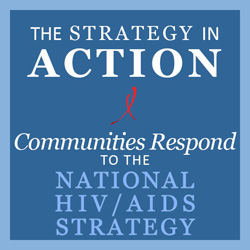Strategy in Action: Region II Convenes National HIV/AIDS Strategy Symposium
Content From: Michelle S. Davis, PhD, Regional Health Administrator, Region II, U.S. Department of Health and Human Services•Published: November 02, 2011•4 min read
Topics

The goals of the meeting were to:
- Educate attendees on the NHAS and provide a one year update
- Provide an overview and update on federal initiatives/efforts in support of the NHAS
- Highlight the importance and encourage federally-funded programs to align to the NHAS
Mr. James Albino, Senior Program Manager at the White House Office of National AIDS Policy (ONAP), served as our Keynote Speaker. Mr. Albino provided an overview and one year update on the NHAS. In his remarks he highlighted the importance of local support on the success of NHAS implementation.
The integration of a live webcast made this event more widely accessible across our region and nation. The participants heard an informative presentation on the HHS 12 Cities Project and NHAS Coordination by Dr. Timothy Harrison, Senior Policy Advisor for the Office of HIV/AIDS Policy (OHAP) at HHS.
Two panel presentations followed the keynotes. The first was comprised of representatives from several federal agencies with key roles in the Strategy’s implementation, including the CDC, HRSA, and the Substance Abuse and Mental Health Services Administration (SAMHSA). Each representative shared brief updates on efforts their agencies had taken over the past year to support the implementation of the NHAS and how these efforts would be unfolding in collaboration with state and local agencies. In addition the Region II Regional Director provided an overview of the Affordable Care Act and its impact on people living with HIV/AIDS (PLWHA).
Our last panel focused on the activities of the two jurisdictions in our region (New York City and Puerto Rico) participating in the 12 Cities Project and CDC’s Enhanced Comprehensive HIV Prevention Plan (ECHPP). Their presentations focused primarily on their activities to date supported by the CDC’s Enhanced Comprehensive HIV Prevention Plan initiative, which is one pillar of the 12 Cities Project. They also mentioned organizational infrastructure, surveillance, data issues, expansion on HIV testing approaches, and the changes to New York State HIV testing laws.
Following these presentations, the participants adjourned into small groups which focused on 1.) identifying areas in which their organizations are already aligned to the NHAS goals and priorities, and, 2.) identifying challenges to align to the Strategy. During the report outs that followed, some of the Strategy-related successes included:
- Priority populations were being targeted.
- Reductions in the newborn infection rate.
- Decreased incidence among injection drug users.
- Reduction in funding for HIV testing in non-traditional settings
- Reduction in overall funding streams
- Continuing disparities among African Americans and Latinos